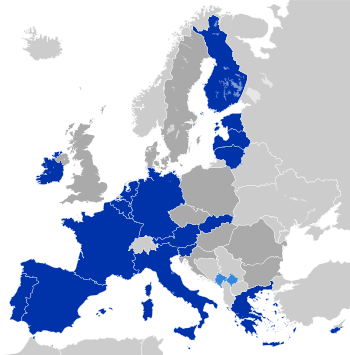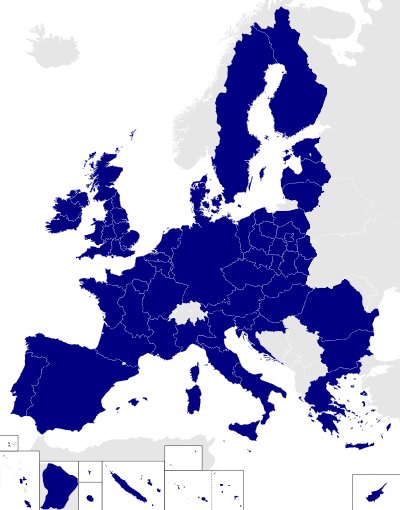High Representative of the Union for Foreign Affairs and Security Policy
| High Representative of the Union for Foreign Affairs and Security Policy
| |||||||||||||||||||||||||||||||||||||||||||||||||
|---|---|---|---|---|---|---|---|---|---|---|---|---|---|---|---|---|---|---|---|---|---|---|---|---|---|---|---|---|---|---|---|---|---|---|---|---|---|---|---|---|---|---|---|---|---|---|---|---|---|
|
Emblem of the EEAS | |||||||||||||||||||||||||||||||||||||||||||||||||
| Appointer | The European Council with the consent of the President of the European Commission | ||||||||||||||||||||||||||||||||||||||||||||||||
| Term length | 5 Years | ||||||||||||||||||||||||||||||||||||||||||||||||
| Inaugural holder |
Jürgen Trumpf (CFSP) Catherine Ashton (FASP) | ||||||||||||||||||||||||||||||||||||||||||||||||
| Formation |
1999 (CFSP) 2009 (FASP) | ||||||||||||||||||||||||||||||||||||||||||||||||
| Deputy | Presidency foreign minister | ||||||||||||||||||||||||||||||||||||||||||||||||
| Website | Council, Commission | ||||||||||||||||||||||||||||||||||||||||||||||||
The High Representative of the Union for Foreign Affairs and Security Policy (HR) is the chief co-ordinator and representative of the Common Foreign and Security Policy (CFSP) within the European Union (EU). The position is currently held by Federica Mogherini.
The post was created under the Treaty of Amsterdam as the High Representative for Common Foreign and Security Policy; it then was occupied by Javier Solana for ten years until it was aggrandised following the Lisbon Treaty providing a seat on the European Commission and chair of the council of EU foreign ministers. Following the Lisbon Treaty the post is assisted by the European External Action Service (EEAS) that was set up in December 2010.[1]
Titles
The formal title of the High Representative is High Representative of the Union for Foreign Affairs and Security Policy. This post was previously styled as High Representative of the Common Foreign and Security Policy and, under the European Constitution, had been designated to be titled the Union Minister for Foreign Affairs. This latter title, as EU Foreign Minister is still applied by commentators and sections of the media as a publicly recognisable shorthand for the post. The style High Representative equates to that of High Commissioner in diplomatic circles.
Role
| European Union |
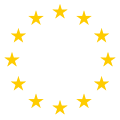 This article is part of a series on the |
Policies and issues
|
Where foreign matters is agreed between EU member states, the High Representative can speak for the EU in that area, such as negotiating on behalf of the member states. The Representative co-ordinates the work of the European Union Special Representatives as well as other appointments such as anti-terrorist co-ordinator.
Beside representing the EU at international fora and co-ordinating the Common Foreign and Security Policy and the Common Security and Defence Policy, the High Representative is:
- ex-officio Vice-President of the European Commission
- participant in the meetings of the European Council
- responsible of the European Union Special Representatives
- head of the External Action Service and the delegations
- President of the Foreign Affairs Council
- Secretary-general of the Western European Union (prior to the abolition of the WEU on 30 June 2011)
- Head of the European Defence Agency
- Chairperson of the board of the European Union Institute for Security Studies
According to proposals made in 2009 by the Swedish EU presidency, the High Representative will control the staffing and budget of the EEAS, and propose the size of budget to be allocated. The High Representative is responsible for appointing EEAS staff and for controlling general foreign policy (outside of trade, development and enlargement which has to be made together with the Commission) including security initiatives and intelligence sharing. However, although the High Representative may prepare initiatives, decisions will still have to be taken by the member states in Council. The High Representative would also have to report to Parliament.[2]
While there has been some criticism of the vague division of powers between the EU's top players, Ukrainian ambassador to the EU Andriy Veselovsky praised the framework and clarified it in his own terms: The President of the European Commission speaks as the EU's "government" while the President of the European Council is a "strategist". The High Representative specialises in "bilateral relations" while the European Commissioner for Enlargement and European Neighbourhood Policy deals in technical matters such as the free trade agreement with Ukraine (here, Veselovsky makes a mistake, as FTAs are actually part of the EU's common commercial policy—for which the European Commissioner for Trade is responsible). The President of the European Parliament meanwhile articulates the EU's values.[3]
With the growth in role of the High Representative, and their exclusion from the European Council, the national foreign ministers are now uncertain of their role vs the High Representative. At an informal meeting in Finland it was mooted that they could serve as special envoys on the High Representative's behalf. This has been backed by Ashton who said that so long as the EU spoke with one voice, it didn't matter who was speaking.[4]
History
The post was introduced under the Treaty of Amsterdam. The Treaty stated that the Secretary-General of the Council of the European Union should have "the function of the High Representative for the common foreign and security policy."[5] Thus, Javier Solana became the first permanent High Representative. Initially the post was much more limited in scope than the present one created in 2009 by the Lisbon Treaty. The current holder of the position is Federica Mogherini.
Lisbon Treaty

The European Constitution proposed to merge the European Commissioner for External Relations with the High Representative to create a Union Minister for Foreign Affairs and Security Policy. Although the Constitution failed to be ratified, its replacement, the Treaty of Lisbon, retained the change under a different name. The new High Representative of the Union for Foreign Affairs and Security Policy would still merge the External Relations Commissioner with the High Representative and, like the Constitution, would have it backed up by an External Action Service.[6][7] The new role also took over other foreign affairs roles, such as chairing the Foreign Affairs Council and representing the EU in international fora, roles which were previously exercised by the foreign minister of the country holding the presidency of the European Union (along with the foreign minister of the country previously holding the presidency and the one to take it next).
Despite the name change, many parts of the media still referred to it as a foreign minister and in negotiations it was decided that the High Representative would no long also be the Council's Secretary-General but would be a Vice-President of the European Commission, filling the now merged Commission post.[7] The merger of the two posts has been seen as furthering the answer to Kissinger's question:
The creation of a High Representative for foreign policy, or, better still, a Minister for foreign affairs would be a big change compared with the current situation. It would put an end to the double job which exists between the current function of Mr Javier Solana, and that carried out within the Commission by Mme Benita Ferrero-Waldner, in charge of the external aid of the EU. One and the same person would therefore deal with problems and respond to the famous telephone calls of Henry Kissinger: ‘ I want to speak to Europe.’ "
Appointments
The High Representative is appointed by the European Council acting by qualified majority. However to take up their role in the Commission, in particular as a vice-president, the High Representative has to appear before Parliament for questioning and then be subject to Parliament's vote of approval on the proposed Commission.
The basic monthly salary of the High Representative is fixed at 130%[9] (higher than a vice-president but less than the Commission President) of the highest grade of the EU civil service (grade 16, step 3),[10][11] which works out at €23,006.98. There are other allowances on top of that as all other conditions of employment for the High Representative are aligned to that of the Commission.[11]
List of office-holders
| № | Photo | Representative | State | Party | In office | Notes | ||
|---|---|---|---|---|---|---|---|---|
| — |  |
Jürgen Trumpf | Germany |
Independent diplomat | 1 May 1999[12] | 18 October 1999 | Acting. | |
| 1 |  |
Javier Solana | Spain |
European: Socialists National: PSOE |
18 October 1999 | 1 December 2009 | As High Representative for Common Foreign and Security Policy Also: Council Secretary-General. | |
| 2 |  |
Catherine Ashton | United Kingdom |
European: Socialists National: Labour |
1 December 2009 | 1 November 2014 | Post expanded by the Treaty of Lisbon. | |
| 3 |  |
Federica Mogherini | Italy |
European: Socialists National: PD |
1 November 2014 | Incumbent | Michel Barnier, to advise EUHRVP Mogherini on important defence and security issues.[13] | |
Javier Solana (1999–2009)
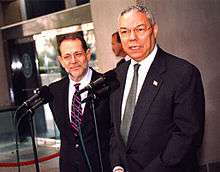
The Amsterdam Treaty introduced the post of High Representative of the Common Foreign and Security Policy to represent the EU on the world stage. It was decided that the Secretary-General of the Council would be the High Representative. This meant that the Secretary-General at the time, Jürgen Trumpf was the first High Representative, although he would only serve a few months.
The first permanent High Representative was Javier Solana, former Secretary General of NATO. He was appointed on 4 July 1999 at the Cologne European Council as Council Secretary-General and High Representative. He took up the post on 18 October 1999, shortly after standing down from NATO. The post had a budget of €40 million, most of which goes to Balkan operations. During his tenure, the position was expanded rapidly, with several more functions combined into the function of High Representative. From 25 November 1999 he was also appointed Secretary-General of Western European Union (WEU), overseeing the transfer of responsibilities from that organisation to the CFSP. In 2004 his 5-year mandate was renewed. He has also become president of the European Defence Agency.
The Clinton administration claimed in May 2000 that Solana was the fulfilment of Henry Kissinger's famous desire to have a phone number to talk to Europe. In December 2003 Solana released the European Security Strategy, which sets out the main priorities and identifies the main threats to the security of the EU, including terrorism. On 25 March 2004 Solana appointed Gijs de Vries as the anti-terrorist co-ordinator for the CFSP, and outlined his duties as being to streamline, organise and co-ordinate the EU's fight against terrorism.
He has negotiated numerous Treaties of Association between the European Union and various Middle Eastern and Latin American countries, including Bolivia and Colombia. Solana played a pivotal role in unifying the remainder of the former Yugoslavian federation. He proposed that Montenegro form a union with Serbia instead of having full independence, stating that this was done to avoid a domino effect from Kosovo and Vojvodina independence demands. Local media sarcastically named the new country "Solania".
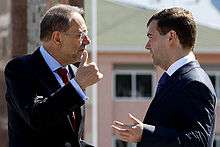
On 21 January 2002 Solana said that the detainees at Guantanamo Bay should be treated as prisoners of war under the Geneva Convention. The EU has stated that it hopes to avoid another war like the Iraqi invasion through this and future negotiations, and Solana has said the most difficult moments of his job were when the United Kingdom and France, the two permanent EU Security Council members, were in disagreement. The so-called Vilnius letter, a declaration of support by eastern European countries for the United States' aim of régime change in Iraq, and the letter of the eight, a similar letter from the UK, Italy, and six second-tier countries, are generally seen as a low-water mark of the CFSP. Solana operated as a quiet diplomat and found himself frequently pushed to the side in negotiations and sent on missions known to be impossible.[14]
Solana has played an important role working toward a resolution to the Israeli–Palestinian conflict, and continues to be a primary architect of the "Road map for Peace", along with the UN, Russia, and the United States in the Quartet on the Middle East. On 22 July 2004 he met Ariel Sharon in Israel. Sharon had originally refused to meet Solana, but eventually accepted that, whether he liked it or not, the EU was involved in the Road Map. He criticised Israel for obstructing the Palestinian presidential election of 9 January 2005, but then met Sharon again on 13 January.
In November 2004 he assisted the United Kingdom, France and Germany in negotiating a nuclear material enrichment freeze with Iran. In the same month he was involved in mediating between the two presidential candidates in the post-election developments in Ukraine, and on 21 January 2005 he invited Ukraine's new President Viktor Yushchenko to discuss future EU membership.[15]
Catherine Ashton (2009–14)
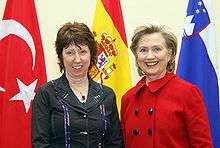
Although Javier Solana was originally selected to be the first Foreign Minister the delays in introducing the post meant after 10 years of service he stood aside for a new candidate. After numerous candidates were put forward, EU leaders agreed on Catherine Ashton from the United Kingdom as the first merged High Representative. Ashton was previously the European Commissioner for Trade and otherwise had no foreign affairs experience. Ashton unexpectedly came to the top of the shortlist when she was nominated unanimously by the centre-left leaders who claimed the post.[16][17] Ashton was confirmed by the European Parliament before she took up the post. In the same European Council meeting, Pierre de Boissieu was appointed Secretary-General of the Council of the European Union, showing that the High Representative and the Secretary-General will no longer be the same person.[18]
In October 2010 most major appointments to the EEAS were made, including Pierre Vimont (France) as Secretary General, Helga Schmid (Germany) and Maciej Popowski (Poland) as Deputy Secretary Generals and David O'Sullivan (Ireland) as chief operating officer. Slowly other staff and ambassadors were appointed in cycles.[19] Ashton formally launched the EEAS on 1 December 2010 at a low key event where she outlined her key priorities as relations with the US and China, climate change, poverty eradication, crisis management and counter-terrorism.[20]
Following the 2010 Haiti earthquake Ashton chaired a meeting of the foreign relations, development and environment DGs and experts from the Council and the Situation Centre (the EU intelligence-gathering agency). There they agreed on €3 million in aid, to look for further financial assistance, to send personnel to assess the situation and to co-ordinate pledges from member states. Ashton then chaired a meeting of member states' ambassadors and acted as a general co-ordinator; for example contacts from the UN went via Ashton. Although she refused to describe it as the first act of the external action service, Ashton did emphasise that it was the first time that such a co-ordination between all the various EU foreign policy actors had been accomplished before. Spain, which held the rotating Council presidency that would have taken charge before the Lisbon Treaty, took a back seat though assisted, for example by offering use of the Spanish base in Panama. However, the majority of aid relief was dealt with bilaterally between Haiti and individual member states[21] and Ashton was criticised afterward for being one of the few foreign representatives not to travel to Haiti personally.[22] Despite EU ministers then agreeing to deploy European gendarmes, criticism was levied at Ashton for failing to improve the EU's international profile during the crisis. Ashton replied stating that "There's been a recognition from the people of Haiti, the US, the UN and others of the extremely important role the EU has played. On the main issue, we should ask, have we tried to save lives, to support the people of Haiti? Yes we have."[23]
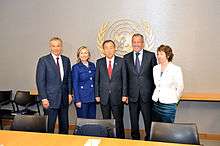
Criticism continued to mount, including complaints that she skipped a defence meeting to attend the inauguration of Ukraine's Prime Minister[24] alleged bias towards British officials, lack of language skills and risking a UK-French feud over creating an EU military planning headquarters.[25] She has been defended by some, including Commissioner Günther Oettinger, on the ground that she has had to take on a job that combines three previous jobs and is working on establishing the EEAS so she is unable to take on everything at once, nor please everyone.[24][25] Despite early Spanish assistance during 2010, Ashton did find herself competing with the Spanish foreign minister on who was going to be speaking for the EU[26] and the need to find consensus between the member states and institutions pushed back the expected operational date of the EEAS from spring 2010 to December 2010.[27] In contrast to the Spanish position, in 2011 Polish foreign minister Radek Sikorski said he would act as Ashton's "loyal deputy".[28]
Secretary General Pierre Vimont joined those defending Ashton from criticism; praising her work in opening the EEAS office in Benghazi, Libya as making the EEAS very popular in Libya. He also supported her over Syria and has asked her to stand for a second term. Polish Minister for Europe, Mikołaj Dowgielewicz, also stated criticism against Ashton was "a lot of hot air" and that "she has an impossible job to do and she is doing it well. At the end of her time in office, people will be more positive about what she has done. She will leave a real legacy."[29]
However, Former European Commission adviser Dr Fraser Cameron argued that "the criticism one hears of Ashton is pretty strong and it will be difficult to overcome the bad press she has. It represents a problem for the EEAS, when it comes to public diplomacy, and reflects the system we have for choosing leaders. Too often, the EEAS is waiting until the last member state signs up to the position; they could set out a view much earlier. When you look at places like Egypt – Cathy has been five times, but people are still not quite sure what the EEAS does or who speaks for Europe. The glass is less than half full. I think the criticism of Ashton is down to style and morale in the EEAS is not as good as it should be."[29]
Ashton chaired the meetings between the E3/EU+3 (P5+1 countries and the EU) and Iran in Geneva,[30] which led to an interim agreement on 24 November 2013, and the Joint Plan of Action.[31][32]
The tone of public comment on Aston's performance in office was subsequently to be influenced especially by her contributions to negotiations over Kosovo and the normalization of its relationship with Serbia, and over Iran over its nuclear program. In October 2013, Der Spiegel wrote of her:
But now the 57-year-old baroness is suddenly at the center of world diplomacy. And whenever she is mentioned, she earns praise for her hard-nosed negotiating skills, her stamina and her diplomatic talents. It is said that U.S. Secretary of State John Kerry has much faith in her. "She is discrete and perceptive, but also tenacious. That makes her an ideal negotiator," says Alexander Graf Lamsdorff, the head of Germany's business-friendly Free Democratic Party (FDP) in the European Parliament and a member of its Committee on Foreign Affairs.[33]
After the November 2013 negotiation of an interim agreement with Iran over its nuclear program,.[31] the Financial Times wrote that Ashton was "no longer the diplomatic dilettante". A senior French diplomat was quoted as saying, "I tip my hat to her.... She truly played a decisive role". The report continued that, after initially insisting on negotiating only with other foreign ministers, by the latter stages of the negotiations the Iranian foreign minister Mohammad Javad Zarif "now... wanted to deal only with Lady Ashton". Said a western diplomat, "That the others agreed to this was significant. For China and Russia to be outside while she was in the room negotiating details was quite remarkable".[34]
Federica Mogherini (since 2014)

In July 2014, given the large number of Italian MEPs belonging to the S&D group following the 2014 election, the European Council considered her as a candidate for the position of High Representative, in Jean-Claude Juncker's new European Commission. On 13 July 2014, the Financial Times among other European newspapers reported that her nomination proposal had been opposed by some eastern European countries, including Latvia, Estonia, Lithuania and Poland, where her stance towards Russia concerning the Ukrainian crisis was considered to be too soft. Nonetheless, on 2 August 2014, Italian Prime Minister Matteo Renzi formally nominated her by letter to EC President-elect Jean-Claude Juncker, as Italy's official candidate for EU Commissioner. On 30 August, Europe's socialist Prime Ministers met prior to the convening of the European Council, at which she received the approval of the Party of European Socialists. On the same day the President Herman Van Rompuy announced that the European Council had decided to appoint the Italian Minister as its new High Representative, effective from 1 November 2014.
At her first press conference she declared her efforts will be devoted to establishing discussions between Russia and Ukraine to solve the crisis between the two countries.
.jpg)
In 2015, Mogherini won praise for her role in negotiating the Joint Comprehensive Plan of Action, an international agreement on the nuclear program of Iran, and along with Iranian Foreign Minister Mohammad Javad Zarif was the one to announce the accord to the world.[35]
In February 2015 the President of the European Commission Jean-Claude Juncker appointed Michel Barnier, the former EU Internal Market Commissioner, as his special advisor on defence and security. Juncker stated that Barnier's role will be to advise the European Commission and particularly the EUHRVP Federica Mogherini on important defence and security issues.[13] Barnier's appointment comes on the heels of the nomination of senior French diplomat Alain Le Roy as the new Secretary General of the European External Action Service (EEAS or EAS).[36]
Treaty basis
The Treaty on European Union, as amended by the Treaty of Lisbon, provides in Article 15(2):
The European Council shall consist of the Heads of State or Government of the Member States, together with its president and the President of the Commission. The High Representative of the Union for Foreign Affairs and Security Policy shall take part in its work.
and in Article 18:
- The European Council, acting by a qualified majority, with the agreement of the President of the Commission, shall appoint the High Representative of the Union for Foreign Affairs and Security Policy. The European Council may end his term of office by the same procedure.
- The High Representative shall conduct the Union's common foreign and security policy. He shall contribute by his proposals to the development of that policy, which he shall carry out as mandated by the Council. The same shall apply to the common security and defence policy.
- The High Representative shall preside over the Foreign Affairs Council.
- The High Representative shall be one of the Vice-Presidents of the Commission. He shall ensure the consistency of the Union's external action. He shall be responsible within the Commission for responsibilities incumbent on it in external relations and for coordinating other aspects of the Union's external action. In exercising these responsibilities within the Commission, and only for these responsibilities, the High Representative shall be bound by Commission procedures to the extent that this is consistent with paragraphs 2 and 3.
— C 115/26 EN Official Journal of the European Union 9.5.2008
See also
- Ambassadors of the European Union
- Common Foreign and Security Policy (CFSP)
- Common Security and Defence Policy
- Council of the European Union
- European External Action Service (EEAS)
- European Union Special Representative
- Foreign Affairs Council
- Foreign relations of the European Union
- High Representative for Bosnia and Herzegovina
- Military of the European Union
References
- ↑ Gateway to the European Union, European External Axis Service – accessed 16 February 2011
- ↑ Rettman, Andrew (23 October 2009) EU states envisage new foreign policy giant, EU Observer
- ↑ Rettman, Andrew (15 March 2010) Ukraine gives positive appraisal of new-model EU, EU Observer
- ↑ Mahony, Honor (15 March 2010) EU foreign ministers ponder their post-Lisbon role, EU Observer
- ↑ "Treaty of Amsterdam amending the Treaty of the European Union, the Treaties establishing the European Communities and certain related acts" (PDF). Retrieved 12 August 2015.
- ↑ The Minister for Foreign Affairs
- 1 2 Honor Mahony: EU leaders scrape treaty deal at 11th hour, EU Observer, 23 June 2007
- ↑ Valéry Giscard d'Estaing: Quelques réponses (4), in his blog, 5 July 2007
- ↑ Council Decision of 1 December 2009 laying down the conditions of employment of the High Representative of the Union for Foreign Affairs and Security Policy, EurLex
- ↑ Base salary of grade 16, third step is €17,697.68: European Commission: Officials' salaries – accessed 19 March 2010
- 1 2 REGULATION No 422/67/EEC, 5/67/EURATOM OF THE COUNCIL, EurLex
- ↑ Appointed Secretary-General of the Council in 1994
- 1 2 "Juncker appoints former rival Barnier as security advisor". EurActiv. 18 Feb 2015.
- ↑ Euobserver.com
- ↑ Clark, Wesley K. Waging Modern War. New York: Perseus Books Group, 2001–2002, p. 15
- ↑ Rettman, Andrew Little-known British peer emerges as top candidate for EU foreign minister, EU Observer 19 November 2009
- ↑ Mahony, Honor EU chooses unknowns for new top jobs, EU Observer 19 November 2009
- ↑ Press release, European Council 2009-11-19
- ↑ Rettman, Andrew (29 October 2010) German and Pole join roll-call of Ashton lieutenants, EU Observer
- ↑ Rettman, Andrew (2 December 2010) Ashton names EU foreign-service priorities at low-key launch event, EU Observer, accessed 20 September 2011
- ↑ Rettman, Andrew (14 January 2009) EU foreign relations chief tests new powers in earthquake response, EU Observer
- ↑ Mahony, Honor (19 January 2010) Ashton under fire for not going to Haiti, EU Observer
- ↑ Rettman, Andrew (25 January 2010) EU gendarmes to help build law and order in Haiti, EU Observer
- 1 2 Banks, Martin (19 March 2010) Criticism of Ashton is 'unfair', theParliament.com
- 1 2 Traynor, Ian (10 March 2010) Ashton defends start in EU foreign policy role, the Guardian
- ↑ Rettman, Andrew (8 June 2010) Poland to showcase its EU credentials in Brussels extravaganza, EU Observer
- ↑ Mahony, Honor (9 June 2010) Negotiators rush to get EU diplomatic service ready EU Observer
- ↑ Rettman, Andrew (2 July 2011) Polish minister pledges loyalty to EU's Ashton, EU Observer
- 1 2 Carroll, Dean (6 September 2011) Catherine Ashton for a second term at the EEAS?, Public Service Europe, accessed 20 September 2011
- ↑ James Reynolds (16 October 2013). "Iran nuclear checks most detailed ever - Ashton". BBC. Retrieved 24 November 2013.
- 1 2 E3/EU +3 nuclear negotiations with Iran: Terms of the agreement on a Joint Plan of Action, including measures to be undertaken by the European Union (PDF) (Report). European Union. 17 January 2014. Retrieved 21 May 2016.
- ↑ "The Iran nuclear deal: full text". CNN. 24 November 2013. Retrieved 5 April 2015.
- ↑ Schmitz, Gregor Peter and Christoph Schult. "Iran Nuclear Talks: Europe's Unsung Chief Diplomat." Spiegel Online International. 1 October 2013. Accessed on 12/30/13 at: http://www.spiegel.de/international/world/catherine-ashton-excells-in-western-talks-on-iran-nuclear-program-a-925514.html
- ↑ Spiegeleisen, Peter. "Ashton no longer the diplomatic dilettante". Financial Times, 27 November 2013.
- ↑ Maïa de La Baume (17 July 2015), The women behind the Iran nuclear deal Politico Europe.
- ↑ "Press release on the nomination of Alain Le Roy as Secretary General of the EEAS". EEAS. 7 January 2015.
External links
- {{Twitter}} template missing ID and not present in Wikidata.
- Mogherini's official term website in the European Commission
- Official website of the post
- Ashton's official term website at the Council of Europe
- Ashton's official term website in the European Commission
- EU – External Action (official site)
- Council Decision of 13 September 1999 appointing the Secretary-General, High Representative for the Common Foreign and Security Policy, of the Council of the European Union on EUR-Lex
- "Presidency Conclusions Brussels European Council 21/22 June 2007" (PDF). Council of the European Union. 23 June 2007. Retrieved 2007-06-26.

